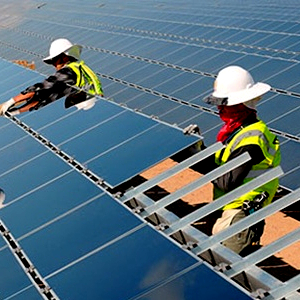Light shed on solar possibilities
 Experts say Brisbane is missing out on significant power possibilities.
Experts say Brisbane is missing out on significant power possibilities.
Not-for-profit solar energy company Australian PV Institute says solar panels in Brisbane's CBD could generate significant savings.
Analysis by the University of New South Wales has taken a stocktake of the solar potential of Brisbane's CBD.
It found that Brisbane could install 188 megawatts of solar on its CBD rooftops, producing enough power to meet 11 per cent of demand.
“This could be done with upfront investment of about $200 million and would payback in electricity repayments $30 million a year,” Australian PV Institute chair Renate Egan said.
Ms Egan said 50 per cent of roofs could have solar panels.
“We've started with Brisbane CBD because Brisbane and Queensland are really proactive around solar,” she said.
“Queensland has got the largest uptake of solar in Australia, with 1.6 gigawatts of solar installed in Brisbane [and] in Queensland, and they have a target of getting to three gigawatts by 2020.”
The institute is using the analysis to push the Queensland Government to let it invest in panels on government buildings such as Suncorp Stadium and the Queensland Performing Arts Centre (QPAC).
“Anything that helps achieve our renewable energy target of 50 per cent by 2030 is being considered,” Queensland Energy Minister Mark Bailey said through a spokesperson.
“Queensland already has one of the highest penetrations of rooftop solar panels in the world, and [those] solar rooftops combined are the second largest power station in Queensland.”
But there is less interest on the federal level, with Minister for Northern Australia, Matt Canavan, calling Queensland's renewable energy target unrealistic.
“It's like trying to develop an alpine skiing industry in Queensland, it's about as realistic as that,” he said.
“We don't have the same renewable resources as say South Australia.
“It would cost an enormous amount of money to build in Queensland and put at risk huge amounts of jobs, particularly in the power sector.
“You've got a Labor state government more interested in the philosophy and ideology of power rather than the practicality and reality of it and providing jobs and a decent cost of living for people.”
Mr Carnarvon said Australia needed to stay in the coal game “as it is in the developing countries we are and plan to export to”.
“The Federal Government supports renewable energy, we have a realistic renewable energy target of 23.4 per cent,” Mr Canavan said.
“And solar hasn't been a huge part of that so far, but it's got great potential.”
But the Grattan Institute’s David Blowers says solar is still more expensive than the current and traditional energy mix of coal, wind and gas.
“Solar is coming down in price. It's still not as cheap as wind or as cheap as building a new gas generator, but it's coming down ... and if it continues on its current path it will become as cheap as wind power in the future,” Mr Blowers said.
“You've got to remember that nowhere in the world has levels of renewables up to 50 per cent at the moment, or at least intermittent renewables, wind and solar.
“So there's serious question marks about what happens when you do get to that level of wind and solar.
“But if that is combined with some form of storage, be that batteries, be that other types of renewables that provide that type of storage, it is possible.
“We would have to see some serious technological improvements over the next decade for that to be achieved.”








 Print
Print